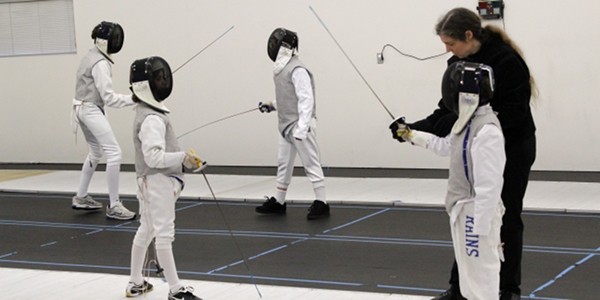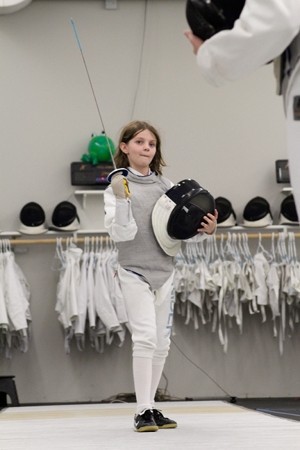About Fencing
Exciting, Safe and Rewarding!
Modern Olympic fencing is a sport for everyone, young and old! Fencing develops not only physical fitness, but also problem solving skills and quick-thinking. If you are new to fencing, feel free to read through our list of fencing FAQs below, along with a brief description of each of the three disciplines of fencing: foil, epee, and saber. Remember, fencing is an exciting, safe and rewarding sport for all ages!
Frequently Asked Questions
Is fencing safe?
Yes. Fencing is one of the safest modern Olympic sports.
Our equipment meets all USA Fencing safety standards and is meticulously inspected for safety by our staff. ICFC instructors are CPR and First Aid certified. We also have an AED on site.
What is fencing?
Fencing is a fast-paced sport where two people attempt to score points by touching their opponant with the tip or side of the blade. There are three variations of the sport, based on what kind of weapon is used during the match. For descriptions of each discipline, please scroll down.
Why fencing?
Fencing is an exciting, safe and rewarding sport appropriate for all ages. It keeps you in shape and develops strategic thinking, as well as being a great stress reliever. It can be competitive, recreational, or both!
When should I (someone) start fencing?
There is no specific age that is ideal for fencing. A fencer can start at age 5 or age 50. There are even national competitions for fencers over 80 years of age. Fencing is a lifetime sport where you can create a style that reflects your personal strengths.
Do I need to buy equipment?
No. The Iowa City Fencing Center provides all necessary equipment and protective gear for classes and club members.
However, if fencers wish to compete in regional, national and international tournaments, it will be necessary to purchase personal equipment. Like all sports, prices vary greatly depending on the maker and quality. If you would like advice on purchasing personal equipment, just ask us at the ICFC, or contact us.
Disciplines
Foil
The foil originated as a training weapon in the 18th century, and its rules are meant to reward correct behavior during bouts. In foil, points are scored when one fencer touches his/her opponent on the torso (including the back) with the tip of the blade. A touch is scored when a fencer has established right of way i.e., the right to attack. Put simply, if you are being attacked, you must defend yourself, and if you are attacking, your goal is to score.
Epee
Epee fencing is based on actual dueling. For epee, the whole body is a target. Points are awarded to the fencer who touches his/her opponent first. When both fencers touch at the same time, both are awarded a point; this is called a double touch. Therefore, the goal of an epee fencer is to touch without being touched. Like foil, epees only score by thrusting with the point of the weapon.
Saber
Saber differs from the other weapons in that it is primarily a cutting weapon; points are scored with the side of the blade, not just the tip. Originally a cavalry weapon, saber has been adapted to modern fencing quite successfully. Of all the weapons, saber is the fastest-paced. Like foil, right of way is used to determine touches. The target is the torso from the waist up and also includes the arms and the head.



